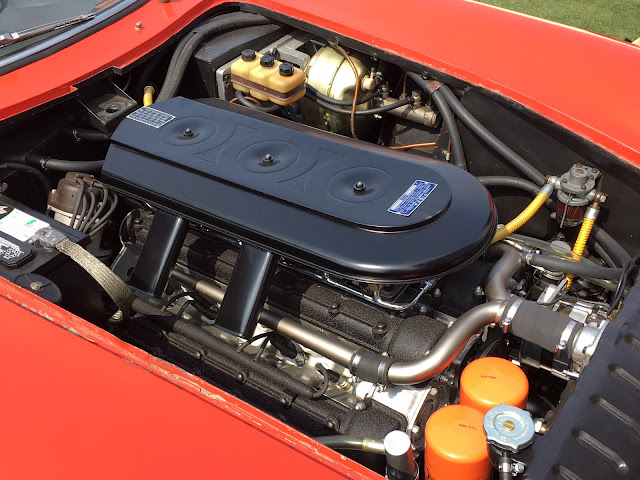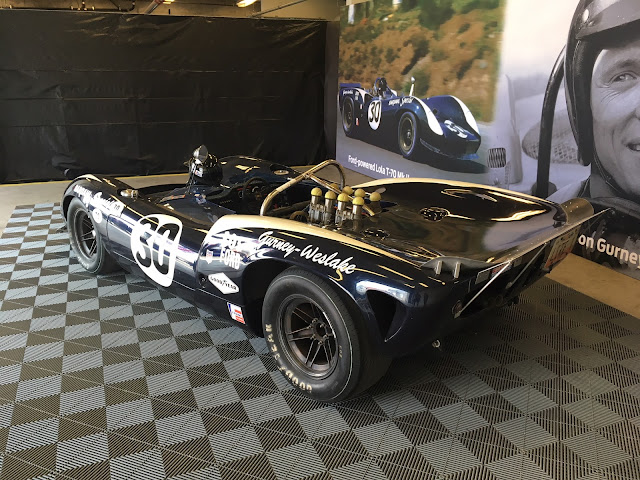The Concorso Italiano was once the bargain-priced upstart of what is now called Monterey Car Week. If you were lucky enough to attend one of the earlier ones, you may remember seeing all kinds of prototypes, racers, one-off show cars, and arcane etceterini, and being treated to stories of racing, repairing and rebuilding these cars by their longtime owners.
Well, the Concorso is still happening, but now the price of admission is $180, not far behind the $250 you get charged for the Pebble Beach Concours. How does it compare to the free show on Ocean Avenue*, or to the variety of cars you might see by spending $60 or $70 for a day of historic race-watching at Laguna Seca? You do get to see some fairly uncommon machinery at the Concorso. The 1936 Alfa Romeo 6C 2500 racer was a prime example, but the postwar 6C 2500 road car in the background (engine shown below) was featured at the free show on Ocean Avenue.
There were a few one-off cars, but some of the most compelling cars at this year's Concorso were production cars rarely seen in the US. One example was this lovely Fiat 2300S coupe, with body styled by Ghia and built by OSI in the early 1960s. The owner had bought the car recently on the Bring a Trailer auction website, and was delighted with the car.
The 2300 and 2300S Ghia coupes were built from 1961 to 1968, when the Dino Fiats took over their place in the Fiat lineup. This example shows the glassy proportions and clean lines reminiscent of the Dual Ghia L6.4 designed around the same time by Sergio Sartorelli. The car is almost exactly the same size as the later BMW 2800CS, wheelbase and all…
The 1961 Maserati 3500 shown below looks like a "standard" Vignale Spyder, but it's actually a unique body built to order with different grille, lighting details, vents and trim than the production model, which was rare enough anyway, with just over 240 built.
The Frua-bodied Mistral which followed the 3500 in Maserati chronology was represented by this well-used example, complete with parking lot dings (I loved it) and a pristine show car in gray. Both had the Lucas fuel injection, which was often replaced in use by Weber carbs.
The Ghia-bodied Ghibli, penned by Giugiaro, was the next Maserati in the line of 2-seaters, appearing in 1967. It was one of the first production cars to use the maestro's "fold and crease" design theme. Engines were 4-cam, dry-sump alloy-block V8s of 4.7 or 4.9 liters, in contrast to the 3.7 and 4.0 liter inline sixes in the Mistrals which preceded them.
Giugiaro also designed this ASA 1000* coupe when he worked for Bertone; the first one appeared in 1960. One of Ferrari's first efforts get what is now called an "entry-level" car into production, it was produced with a single overhead cam inline four which was essentially 4 cylinders of the Ferrari 250 V12. Potential buyers were not thrilled with paying twice the price of an Alfa Giuietta for a car with less power, so the De Nora family which built the cars took quite a long time to sell not many more than a hundred.
The ASA's rounded contours have more in common with the Iso Grifo pictured at the end of this piece, also a Giugiaro design, than with the more sharply defined planes of the Ghibli.
Any early-1950s Ferrari is a rarity, and any Ghia-bodied Ferrari is a scarce treat to encounter. This car is both. A few of these bodies were built by Ghia on the Ferrari 195S chassis (2.3 liters) which came after the famed 166. At least one car competed in the Carrera Panamericana, the road race across Mexico. The grille is interesting, as designers had not yet made the oval egg-crate design pioneered by Touring and Vignale a universal feature on Ferraris.
My selection of favorite Ferraris concludes with 275GTB4 below, a sister car to the immaculate example found at the Hillsborough Concours* in July, featuring the first 4-cam V12 to appear in a production Ferrari Berlinetta. The car was in what is now called "barn-find" condition by show-goers. What that really means is that it looks like a used car, complete with cracked and chipped paint.
Here's that engine. If the owner keeps driving the car and refuses to restore it, he or she will have decisively avoided what Jean Jennings at Car and Driver once called the "dead car in a plastic box syndrome." The happy guy in the photo below has been avoiding that syndrome since 1961 with his 1951 Siata 1400 Spider.
He seemed glad to talk with me about driving and working on the car over all those years. This 1400 spider is likely the only Siata 1400 still running its original engine. When I asked why, he told me that the Siata-modified inline fours were "powder kegs." After 57 years with this car, he's turning it over to his son this year. The alloy body is by Stablimenti Farina, a sister (or really, brother) company to Pinin Farina. Like the maroon Alfa in the top photo, this car was also featured in the Ocean Avenue show on Aug. 21. Other than a couple of Abarths, this Siata was the only species of etceterini on the field…
That scarcity, along with a scarcity of owners who knew as much about their cars as this guy, is another measure of the changes in the Concorso. The owner of the 1924 Lancia Lambda Series 4 below had a similar long-term commitment to his car, and was ready to show some of its unusual features. The Lambda was the first production car to feature unit body construction. It also featured a narrow-angle V4, another first. In the photo below, the owner demonstrates the clever spotlight, which can be removed from its mounting to double as an under-hood trouble light.
 |
The Lancia Aprilia pictured above and below was mobbed, despite its scruffy, well-used condition…another escapee from the "car in plastic box" syndrome. And what a car it was. Unit construction, narrow-angle V4, and what became a signature Lancia feature, the suicide doors opening to reveal the whole interior, with no B-pillar. Along with the Citroen Traction Avant which also appeared in 1934, it pointed the way to the modern car.
The Superleggera Touring-bodied Flaminia below brings back memories of similar coupe I once owned. Close examination revealed details I failed to remember, like the tiny crease formed into the alloy door skin that fades away two-thirds of the way across the window sill.The whole car was full of those kinds of expensive details. Like the Aurelia, it had an alloy 60 degree V6 and a four-speed transaxle…
Rounding out the survey of Lancia design history is this Fulvia Zagato I found not in the show, but in the parking lot. Narrow angle V4, front wheel drive, teardrop shape formed in alloy on early models and steel later on…
Rounding out the survey of Lancia design history is this Fulvia Zagato I found not in the show, but in the parking lot. Narrow angle V4, front wheel drive, teardrop shape formed in alloy on early models and steel later on…
And below is a not-quite-Lancia, the New Stratos, which is not coming to a dealer near you anytime soon. For the story of the New Stratos, you may want to refer to the post called "Lost Cause Lancias" from 2/15/18.
The Concurs afforded a chance to see some of the Lamborghinis I missed at their feature event in Hillsborough last month. But really, there were more of them here, including the two Isleros shown below. These updated versions of the 400 GT were built by Marazzi when Superleggera Touring closed. Note that the later car in green has vent windows in the doors, while the earlier one doe not.
No Lambo review would be complete without a Miura*, and you might as well have a lime yellow one with bright blue interior, right?
There were many reasons I enjoyed the free show on Ocean Avenue more than this one, and one of them is that there was no thumping techno music, no fashion show, and there was a greater diversity of cars. That's also true of comparisons with earlier Concorsos. Yes, I know the early concours in Europe had fashion shows too, but when there is a transverse-mounted V12 sharing its oil with the transmission to discuss (see above), it seems fashion is a distraction. A photographer (perhaps from some lifestyle journal, not from a car mag) asked me about the car below, and wanted to know if it was some kind of "Austin Martin". I had not the heart to tell him there never were any Austin Martins. He was amazed to find out that the Iso Rivolta and the Grifo pictured were made by the same people who designed the egg-like Isetta 300 later built by BMW. "Iso as in Isotherm", I pronounced. "They actually made refrigerators before they made cars." It is really irresponsible to distract guys trying to have a serious discussion about refrigerators with a parade of supermodels pirouetting across a manicured fairway to booming electronic dance music. The best way to enjoy Monterey Car Week, unless you want to buy a car at auction, is to check out the free show Tuesday on Ocean Avenue, and then spend the weekend at the races.
*Footnotes: The Hillsborough Concours was featured in two parts on July 26 and 29, 2018.
The saga of the ASA cars appeared in our Etceterini Files for 2/2/16. The design story of the Miura was recounted briefly in our post for 7/11/17, and the free car show on Ocean Avenue in Carmel appeared in two parts on August 21 and 25, 2018. These overviews of Monterey Car Week 2018 mark the third anniversary of this blog, which has only a few intrepid subscribers but has had over 73,500 visits over the years. Thanks for having a look.
Photo credits: All photos are by the author, including the blurry impressionistic ones.
Errata: The first version of this account reported that just over 100 Maserati 3500 Spyders were built; the real number was 245.
















































